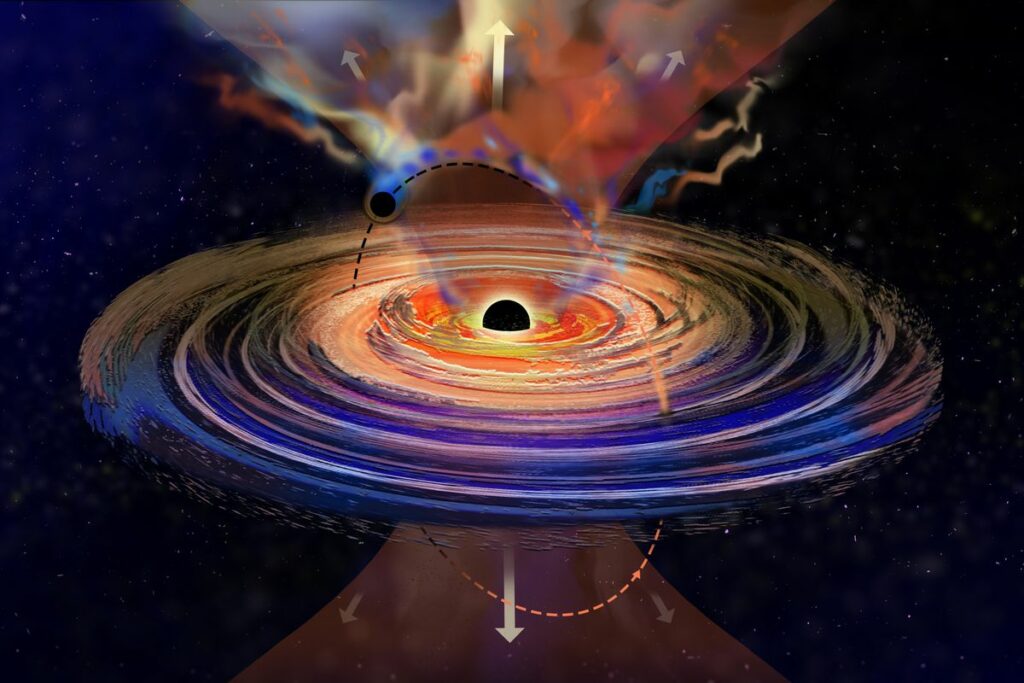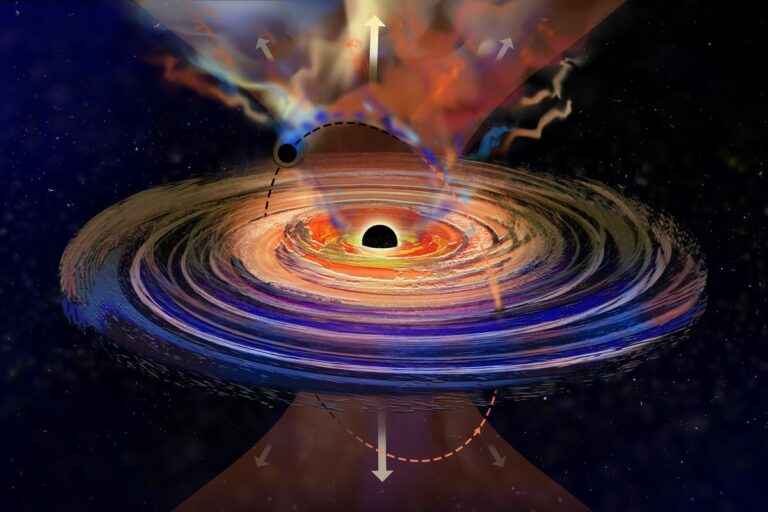The initial observation of a ‘hiccupping’ black hole has resulted in an unexpected revelation of a second black hole in orbit around it.
Scientists have made a remarkable discovery of a colossal black hole that experiences periodic ‘hiccups’ every 8.5 days. It appears that a smaller black hole, which consistently punctures through its accretion disk, could potentially be the cause of this intriguing phenomenon.
Astronomers have detected the initial occurrence of a black hole “hiccup” from a distant cosmic giant. The cosmic burps indicate that the swirling disks of matter and gas surrounding black holes may host larger cosmic entities than previously believed.
The colossal black hole, equivalent in weight to about 50 million suns and residing in the core of a galaxy 800 million light-years away from Earth, is expelling chunks of gas into space approximately every 8.5 days before falling silent once more. These “hiccups” originate from the black hole’s accretion disk, a ring of superheated gas revolving around the entity.
A recent research, released on March 27 in the journal Science Advances, proposes that this material is being emitted due to a second, smaller black hole moving in and out in a tilted orbit, stirring up gas akin to a swiftly flying bee traversing through a cloud of pollen.
The unexpected nature of these hiccups was highlighted by Dheeraj Pasham, the lead author of the study and a research scientist at the Kavli Institute for Astrophysics and Space Research in Massachusetts. After months of puzzlement, an explanation was finally provided by theorists from the Czech Republic, shedding light on the presence of a secondary black hole that seems to account for all the characteristics of this system.
The findings indicate that the accretion disks surrounding black holes could harbor a diverse range of celestial bodies, such as other black holes and stars.
Pasham remarked, “We believed we had a comprehensive understanding of black holes, but this discovery indicates there is much more to learn about their capabilities.” He further explained to Live Science, “If our hypothesis regarding a companion black hole disrupting the accretion disk repeatedly is accurate, these hiccups could reveal a whole new population of such extreme binary systems.”
The researchers anticipate that the powerful gravitational pull of the supermassive black hole will eventually consume its companion black hole through a merger, a process that may take more than 10,000 years to unfold. Pasham elaborated to Live Science, “Due to the significant difference in mass between the smaller black hole and the primary one, the merger is expected to occur over an extended period.”
A tale of two black holes and an ill-fated star
In December 2020, the monstrous black hole caught the attention of astronomers. The All Sky Automated Survey for SuperNovae (ASAS-SN) telescopes detected a continuous burst of light emanating from its accretion disk. This survey identified a luminous event, designated ASASSN-20qc, which intensified the brightness of a specific region in the sky by a factor of 1,000. Lasting for a duration of four months, this luminous flash is believed to have resulted from the supermassive black hole tearing apart a neighboring star.

After consulting with peers, the scientists concluded that the black hole experienced hiccups each time the smaller orbiting black hole passed through the accretion disk, expelling more material than usual.
Despite being the smaller black hole in the system, the secondary black hole is not insignificant in size. Researchers estimate its mass to be equivalent to that of 100 to 10,000 suns, categorizing it as an intermediate black hole. The substantial difference in mass between the two black holes, differing by a factor of 5,000, makes this newly discovered pair one of the most extreme mass ratio binaries identified to date.
“This is a unique entity,” Pasham stated. “It does not conform to our current understanding of these systems.”
In the upcoming months, the scientists will continue to observe this system while investigating other systems displaying similar hiccups, as mentioned by Pasham to Live Science. If these black hole binaries also exhibit significant mass differences like the newly discovered pair, then the recently launched European Space Agency telescope, LISA, should be capable of detecting them. “We expect to be quite occupied in the next few years as we analyze this new population.”




0 Comments